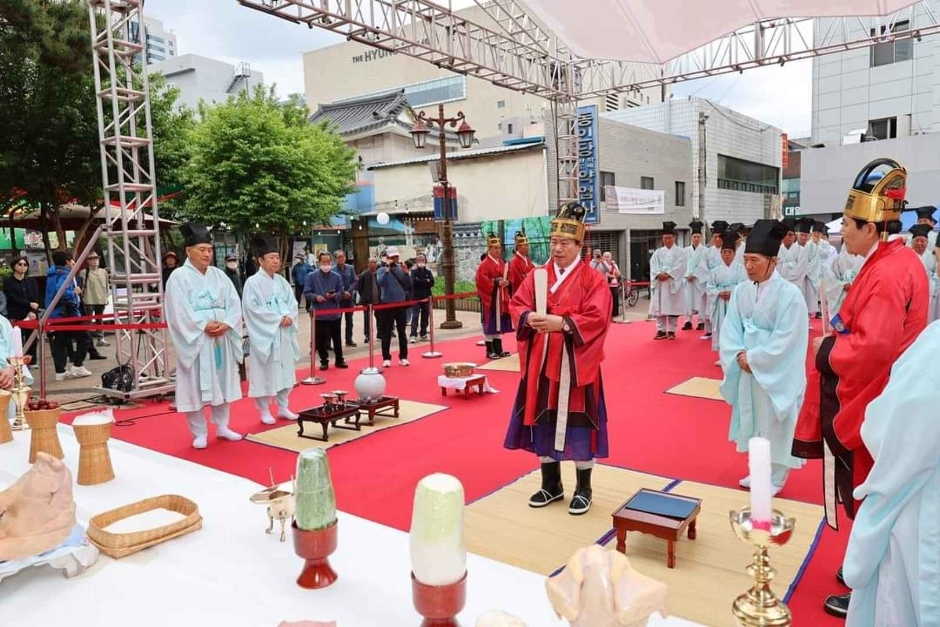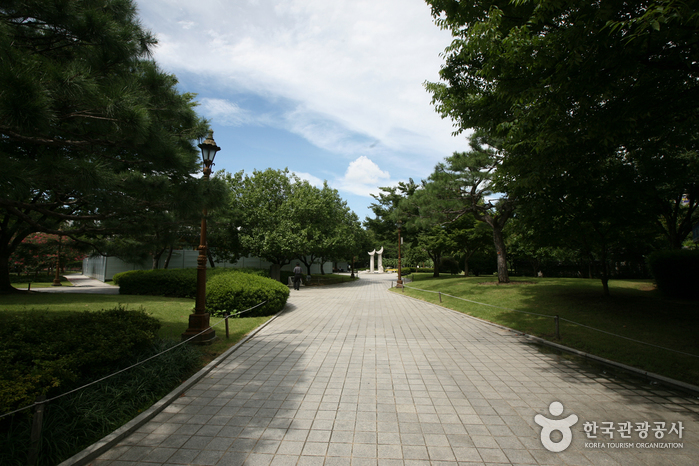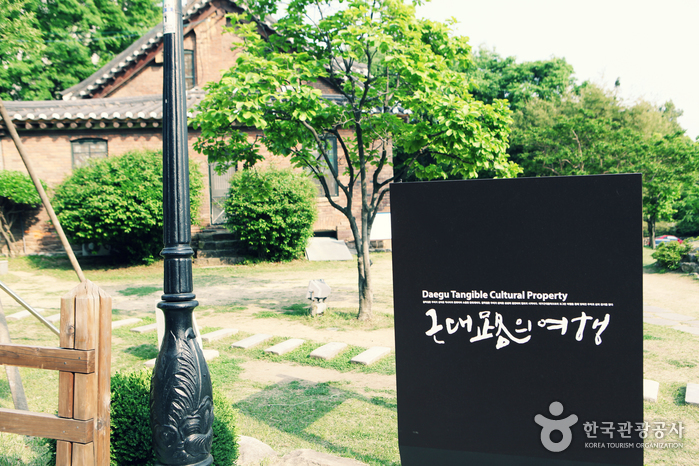Starbucks Daegu Jongro Old House (스타벅스 대구종로고택)
1.0Km 2024-12-27
22 Jungang-daero 77-gil, Jung-gu, Daegu
Special Starbucks store where the past and present meet in harmony
.Starbucks Daegu Jongro Old House store conserved the beautiful architectural style of a hanok house built in 1919 and reinterpreted with the modern touch. The store is composed of two hanok buildings and a garden. There is a separate building for restrooms. Here, you can enjoy the scenery of the four seasons and the history from past to present. The store also offers high-quality audio sound in collaboration with Bang & Olufsen, who was inspired by Daegu, the origin of Korea’s modern music cafe and the city of culture and art. The store sits in the middle of the Jingolmok Alley, the second course of the Modern Cultural Alley Tour, and has become a tourists’ beloved destination and landmark in Daegu. This special store serves as a guide that indirectly delivers a historical meaning.
Daegu Medicinal Herb Wholesale Market (대구 한약재 도매시장)
1.0Km 2021-06-01
51-1, Namseong-ro, Jung-gu, Daegu
+82-53-257-0545
Daegu Medicinal Herb Wholesale Market, also known as Daegu Yangnyeongsi, is a major herbal medicine market specializing in the practices of Oriental medicine. The market dates all the way back to the Joseon dynasty, when the governor of Gyeongsang-do at that time supplied the best medicinal herbs to the central administrative office and sold the rest to the commoners. Among the many cities that served as suppliers of herbal medicine, Daegu survived as the longest and remained the most active. Until 1910, Daegu was at the center of the herbal medicine world, providing Oriental medicine to travelers from all around the world including Japan, China, Russia, Manchuria and many other countries. Even to this day, Daegu Yangnyeongsi continues to supply herbal medicine across the country and preserve the traditional medicine culture that has been passed down for over 350 years.
Daegu Yangnyeongsi Herbal Medicine Festival (대구약령시한방문화축제)
1.0Km 2025-01-08
51-1 Namseong-ro, Jung-gu, Daegu
+82-53-253-4729
Daegu Yangnyeongsi Herbal Medicine Festival, held in the 366-year-old Daegu Yangnyeongsi, offers a rich experience of traditional herbal medicine culture. Visitors can enjoy free consultations with herbal medicine doctors, herbal foot baths, and unique programs such as Joseon Gutpan: Herbal Club and Zombie Street.
Daegu Goods - Daegu Branch [Tax Refund Shop] (대구굿즈 대구)
1.1Km 2024-04-19
1F, 69, Seoseong-ro 14-gil, Jung-gu, Daegu
-
Gyeongsanggamnyeong Park (경상감영공원)
1.1Km 2018-08-07
99, Gyeongsanggamyeong-gil, Jung-gu, Daegu
+82-53-254-9404
Located in central Daegu, Gyeongsanggamyeong Park was built during the 34th year of King Seonjo of the Joseon Dynasty (1601) and was the original location of Gyeongsanggamyeong (1910), the office of the Gyeongsangbuk-do governor. In 1965 the provincial office was moved to another location and the park opened its doors to the public under the name of Central Park. The park was renamed again in 1997 and has been known as Gyeongsanggamyeong Park ever since.
Many cultural and historical heritages are located in the park including the Seonhwa-dang building where the governor worked (Daegu Tangible Cultural Property No.1); the Jungcheong-gak building that was one of the governor’s residences (Daegu Tangible Cultural Property No.2); and Seonjeong-bi gravestone where governor’s achievements are engraved. Seonhwa-dang building in particular has historical significance since it is one of the few remaining government buildings.
The park is well loved by citizens for its green forest, beautiful flowers, well-developed grass plaza, scenic fountain area, and its comfortable walking paths.
Daegu Modern History Streets (Tour of Modern Streets) (대구 근대골목(근대로의 여행))
1.1Km 2023-10-27
66, Gukchaebosang-ro 102-gil, Jung-gu, Daegu
+82-53-661-3327
Daegu Modern History Streets is an experiential tour that brings the participants across Daegu’s alleyways and living history. During the Korean War, Daegu was much less damaged than other regions. Because of that, the city retains the changes in lifestyles before and after the war relatively well.
There are 13 courses in total, run by regional self-governance groups in Daegu, defined according to different themes and areas. The most popular among them is Course 2, the Modern Cultural Street, which takes visitors on a tour of major sites associated with Daegu’s modernity. Follow the retro aesthetics and the history of Daegu and Korea along places like Kyesan Catholic Church, Jeil Church, old houses, and the former Chinese Elementary School.
Note that multilingual tours are offered to international visitors in English, Japanese, and Chinese, in regular tours (14:00 every Saturday) and on-demand tours (available for groups of more than 5). Reservations are offered on the official website.
Samsong Bakery main store (삼송빵집 본점)
1.1Km 2024-10-18
397 Jungang-daero, Jung-gu, Daegu
Daegu's representative bakery f(x) KRYSTAL visited
This place opened in 1957 and became famous after a broadcast of KRYSTAL eating bread here, hence it is called Daegu's representative bakery. The best menu is Whole Corn Bun, Squid Ink Whole Corn Bun, Vegetable Croquettes, Streusel Bun with Red Bean Filling, and Cream Cheese Sweet Rice Cake Bread. The high ceilings and chandeliers are impressive. When you go up to the second floor, you will find a minimalist cafe-like atmosphere with simple tables placed in a wide space.
Gugil Ttarogukbap (국일따로국밥)
1.1Km 2020-05-04
571, Gukchaebosang-ro, Jung-gu, Daegu
+82-53-253-7623
Unlike traditional gukbap (rice soup), the rice and the soup in Ttarogukbap are served separately. It is a speciality in Daegu, and the main dish served at Gugil Ttarogukbap. The restaurant makes the broth with beef bones, and adds spices, meat and coagulated ox blood to complete the rich and flavorful soup. Meanwhile, the restaurant was designated as a site of master craftsmanship by the Korean Traditional Culture Preservation Committee, as well as an authentic local speciality restaurant in Daegu.





![Seobong Shoes [Tax Refund Shop] (서봉제화)](http://tong.visitkorea.or.kr/cms/resource/67/2883967_image2_1.jpg)
 English
English
 한국어
한국어 日本語
日本語 中文(简体)
中文(简体) Deutsch
Deutsch Français
Français Español
Español Русский
Русский